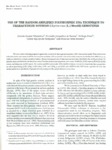Use este identificador para citar ou linkar para este item:
http://www.alice.cnptia.embrapa.br/alice/handle/doc/471630| Título: | Use of the random amplified polymorphic DNA technique to characterize soybean (Glycine max (L.) Merrill) genotypes. |
| Autoria: | VILARINHOS, A. D.  BARROS, E. G. de   PAIVA, E.   SEDIYAMA, C. S.   MOREIRA, M. A.   |
| Afiliação: | EMBRAPA-CNPMS. |
| Ano de publicação: | 1994 |
| Referência: | Revista Brasileira de Genética, Ribeirão Preto, v. 17, n. 3, p. 287-290, 1994. |
| Conteúdo: | We have started a breeding program to genetically eliminate. the lipoxygenase isozymes (LOX) from soybean seeds. These enzymes are believed to be lhe main cause of off-flavors in soybean products. LOX are present in the seed as three isozymes encoded by Ihree different genes, which are inherited in a simple mendelian fashion. Mutants lacking each one of these isozymes have been identified in the world gennplasm. To introduce Ihese null ali eles into lhe Brazilian variety Cristalina, three mutant progenitors were chosen PI 408.251 (LOX 1 minus), PI 86.023 (LOX2 minus), and Ichigowase (LOX3 minus). The random amplified polymorphic DNA (RAPD) technique was used to characterize these progenitors, as well as lines lacking LOXI (CRI), LOX3 (CR3), LOXI and 3 (CRI,3), and LOX2 and 3 (UFV 91-263, UFV91-401 and UFV 91-717). The results enabled us to establish lhe fmgerprint of each genotype and the genetic distances among them. |
| Thesagro: | Soja Melhoramento genético vegetal Glycine Max |
| NAL Thesaurus: | Plant breeding |
| Tipo do material: | Artigo de periódico |
| Acesso: | openAccess |
| Aparece nas coleções: | Artigo em periódico indexado (CNPMS)  |
Arquivos associados a este item:
| Arquivo | Descrição | Tamanho | Formato | |
|---|---|---|---|---|
| Userandom.pdf | 3.64 MB | Adobe PDF |  Visualizar/Abrir |









